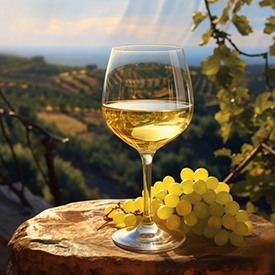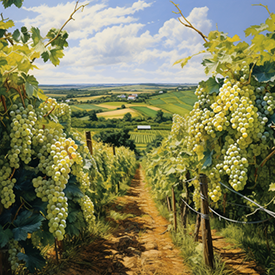Why White Wines Ditch the Skins
Posted by Matteo Lahm on 22nd Jul 2023
You, my curious home winemaker, may have wondered why white wines are often fermented without their skins. It's a fascinating tale that takes us back through history, revealing the origins of this standard technique and the minds behind it. So, grab a glass of your favorite white wine, sit back, and let's embark on this enlightening journey together.
The Birth of White Wine Fermentation:
In the early days of winemaking, as far back as ancient times, winemakers were constantly exploring various techniques to craft the perfect libation. It was during this experimental period that a significant discovery occurred, forever changing the course of white wine production.
While the exact details may be lost to history, it is believed that winemakers, through a combination of trial and error, stumbled upon the concept of fermenting white grapes without their skins. This accidental occurrence led to the creation of a delightful, crisp, and refreshing white wine, much to the surprise and delight of those who tasted it.
This serendipitous discovery marked a turning point in winemaking, as it revealed the potential for producing white wines with distinct characteristics and flavors. The absence of the grape skins during fermentation allowed for a lighter and more delicate wine, showcasing the true essence of the grapes themselves.

Over time, this fortuitous accident became recognized as a viable technique for white wine production. Winemakers began intentionally fermenting white grapes without their skins, harnessing the unique qualities that this method offered. The resulting wines were praised for their vibrant acidity, fruit-forward profiles, and the ability to capture the essence of the grape varietals.
While the specific origins and individuals responsible for this discovery may remain shrouded in mystery, the impact of fermenting white wines without skins is undeniable. It has become a fundamental practice in winemaking, shaping the way we enjoy and appreciate white wines today.
The pioneers of white winemaking in the Middle Ages were not only driven by serendipitous accidents but also by a growing understanding of the characteristics of white grapes. While I couldn't find specific documentation from that era, historical records and writings from later periods shed light on the development of this technique.
In regions like Burgundy and Champagne, winemakers began to notice that white grapes had thinner skins and lower levels of tannins and pigments compared to their red counterparts. This observation led them to experiment with fermenting white grapes without their skins, as they believed that prolonged skin contact would not contribute positively to the final product.
One notable figure in the history of white winemaking is Dom Pérignon, a Benedictine monk from the Champagne region. Although he is often associated with the development of sparkling wine, Dom Pérignon also played a role in refining the techniques for producing white wines. His meticulous observations and experiments in the vineyards and cellars of the Abbey of Hautvillers contributed to the understanding of the unique characteristics of white grapes and their optimal winemaking processes.
While specific documentation from this period may be scarce, the knowledge and practices developed by these pioneers were passed down through generations of winemakers. Their insights and experiences laid the foundation for the modern techniques used in white winemaking today.
It's worth noting that the evolution of winemaking techniques was not solely based on scientific understanding but also on trial and error, intuition, and a deep connection to the land. The art of winemaking is a delicate balance between tradition and innovation, and the pioneers of white winemaking played a crucial role in shaping the techniques we employ today.
To delve deeper into the history of white winemaking, I recommend exploring books such as "The Oxford Companion to Wine" by Jancis Robinson and Julia Harding, "Wine Grapes" by Jancis Robinson, Julia Harding, and José Vouillamoz, or "The World Atlas of Wine" by Hugh Johnson and Jancis Robinson. These authoritative sources provide comprehensive insights into the history, techniques, and evolution of winemaking practices, including those specific to white wines.

The Influence of Science: Unleashing the Fermentation Revolution
Now, let's dive deeper into the fascinating world of white wine fermentation and the remarkable contributions of the legendary French chemist, Louis Pasteur. Brace yourself, my fellow wine enthusiast, for this is where the story takes an intriguing turn.
In the 19th century, Pasteur, armed with his scientific prowess, embarked on a quest to unravel the mysteries of fermentation. He peered into the microscopic world, examining the role of yeast in this magical process. Through his groundbreaking research, Pasteur discovered that yeast is the true hero behind the transformation of grape juice into wine.
But that's not all! Pasteur's genius didn't stop there. He also shed light on the crucial role of temperature control in winemaking. He revealed that by carefully managing the fermentation temperature, winemakers could influence the flavors and aromas of their wines. This revelation was a game-changer, especially for white wines.
You see, my friend, white wines are delicate creatures. They possess a vibrant array of flavors and aromas that can be easily overshadowed by excessive tannins and pigments found in grape skins. Pasteur's research highlighted the importance of keeping the fermentation temperature low for white wines, allowing them to retain their freshness and fruitiness.
Thanks to Pasteur's scientific insights, winemakers around the world began to embrace temperature-controlled fermentation chambers. These modern marvels allowed them to maintain a cool and controlled environment, ensuring that the delicate nuances of white grapes were preserved throughout the fermentation process.
Imagine the excitement among winemakers as they realized they could now craft white wines with precision, capturing the essence of the grapes without any unwanted distractions. The flavors became crisper, the aromas more vibrant, and the overall drinking experience simply delightful.
So, the next time you savor a glass of your favorite white wine, take a moment to raise it high and toast to the brilliance of Louis Pasteur. His scientific discoveries revolutionized the world of winemaking, forever shaping the way we produce and enjoy white wines. Cheers to Pasteur, the unsung hero behind the scenes, ensuring that each sip of white wine is a moment of pure pleasure.
Why Skins Don't Make the Cut:
Now, you might be wondering, "Why bother fermenting white wines without their skins?" Well, my friend, it's not just about avoiding excessive tannins; there's another sneaky culprit hiding in those grape skins that can wreak havoc on the delicate nature of white wines. Let's dive deeper into the world of pigments and discover why they don't make the cut.
When we think of pigments in wine, our minds often drift to the rich, deep colors of red wines. But did you know that even white grapes have pigments lurking within their skins? Yes, those seemingly innocent green grapes have their own little secret. These pigments, known as polyphenols, can add a touch of color to white wines, turning them slightly golden or amber.
Now, you might be thinking, "What's wrong with a little color?" Well, my friend, it's all about the desired flavor profile and the visual appeal of white wines. Winemakers strive to create wines that are crisp, vibrant, and visually enticing. The presence of pigments from the grape skins can alter the appearance of white wines, making them appear dull or even slightly oxidized.
But that's not all. These pigments can also contribute to a phenomenon known as "browning" in white wines. When exposed to oxygen, the polyphenols in the grape skins can react and cause the wine to take on a brownish hue. Now, I don't know about you, but I prefer my white wines to resemble a sun-kissed meadow, not a murky swamp.
By fermenting white wines without their skins, winemakers can avoid these pigment-related pitfalls. They can ensure that the wine remains crystal clear, with a pale and inviting color that entices you to take a sip. This technique allows the true character of the grapes to shine through, unencumbered by unwanted pigments, and creates a visually stunning wine that is as pleasing to the eye as it is to the palate.
So, my friend, the next time you raise a glass of your favorite white wine, take a moment to appreciate the winemakers who have mastered the art of skinless fermentation. They have skillfully navigated the challenges posed by both tannins and pigments, crafting a wine that is not only light, crisp, and fruit-forward but also visually captivating. Cheers to the winemakers who know that sometimes, less pigment means more pleasure in every sip!

